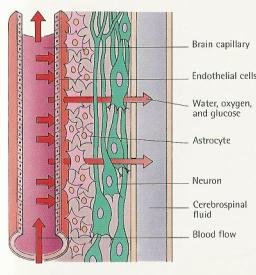Blood-Brain Barrier
A mechanism which controls the passage of substances from blood to the cerebrospinal fluid and therefore in the brain and spinal cord. The blood-brain barrier (BBB) lets necessary metabolites, like oxygen and glucose, pass from the blood to the brain and central nervous system (CNS) but blocks mainly molecules which are more massive than about 500 daltons. This is in low mass in biomolecular terms and that means everything from hormones and neurotransmitters to viruses and bacteria are refused access to brain by the BBB.

Figure:Blood Brain Barrier
A mechanism which controls the passage of substances from blood to the cerebrospinal fluid and therefore in the brain and spinal cord. The blood-brain barrier (BBB) lets necessary metabolites, like oxygen and glucose, pass from the blood to the brain and central nervous system (CNS) but blocks mainly molecules which are more massive than about 500 daltons. This is in low mass in biomolecular terms and that means everything from hormones and neurotransmitters to viruses and bacteria are refused access to brain by the BBB.
The idea of the blood brain barrier was first discovered in the late 19th century by Paul Ehrlich. He establishes that intravenous injection of dyes in the bloodstream stained all the tissues in nearly all organs except the brain. By using electron microscopy and electron-dense tracers like horseradish peroxidase (HRP) a group of scientists elaborated that the blood-brain barrier is positioned in endothelial cells of capillaries of the brain.
Key functions of the BBB are:
1) Protecting the brain from "foreign substances" (like viruses and bacteria) in the blood which could injure the brain.
2) Defending the brain from hormones and neurotransmitters in the rest of the body.
3) And maintaining a constant atmosphere (homeostasis) for the brain.